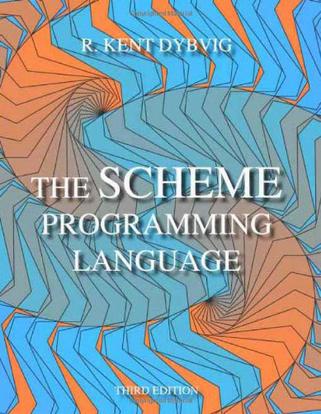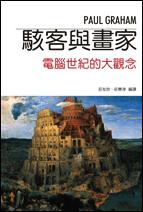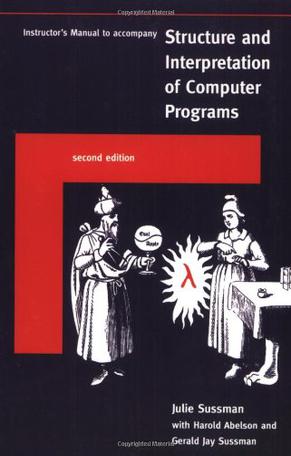欢迎来到相识电子书!
标签:LISP
-
The Scheme Programming Language
This thoroughly updated edition of The Scheme Programming Language provides an introduction to Scheme and a definitive reference for standard Scheme, presented in a clear and concise manner. Written for professionals and students with some prior programming experience, it begins by leading the programmer gently through the basics of Scheme and continues with an introduction to some of the more advanced features of the language. Many exercises are presented to help reinforce the lessons learned, and answers to the exercises are given in a new appendix. Most of the remaining chapters are dedicated to the reference material, which describes in detail the standard features of Scheme included in the Revised Report on Scheme and the ANSI/IEEE standard for Scheme. Numerous examples are presented throughout the introductory and reference portions of the text, and a unique set of extended example programs and applications, with additional exercises, are presented in the final chapter. Reinforcing the book's utility as a reference text are appendixes that present the formal syntax of Scheme, a summary of standard forms and procedures, and a bibliography of Scheme resources. The Scheme Programming Language stands alone as an introduction to and essential reference for Scheme programmers. It is also useful as a supplementary text for any course that uses Scheme. The Scheme Programming Language is illustrated by artist Jean-Pierre Hebert, who writes Scheme programs to extend his ability to create sophisticated works of digital art. -
LISP语言
本书共十四章。一至三章介绍lisp的基本语法、语义、s表达式的概念、以及lisp的核心部分lisp1;四至十章主要讨论lisp的函数程序设计方法;十一至十三章是lisp的非函数程序设计部分;十四章介绍lisp中的一些高级成分和高级应用。 本书以lisp语言为素材,注重训练学生的函数式程序设计能力。书中用形式化的方法来表述lisp的语义,旨在提高学生的理论素养,同时,书中有大量的习题和例题,涉及到lisp的基本概念直至人工智能领域中的高级应用。仔细阅读这些程序并认真作习题,对学好本课程是十分有益的。 本书可用作高等院校计算机专业的教材或参考书,也可供从事人工智能工作的研究人员、工程技术人员参考。 -
駭客與畫家
本書檢視駭客的世界,以及駭客活動背後的動機。在這個日漸電腦化的世界裡,駭客是個帶有多重意義的名詞,它對創意使用者帶來尊崇,也對規矩破壞者帶來鄙視意味。Paul Graham 的散文引領讀者瀏覽他筆下的駭客世界,一個聰明才智泛流的新荒野。 為什麼一個唸不完高中的孩子,最後卻晉身為世上最有權勢的人?科技是否將建立出新的鴻溝,一端是懂得使用科技的人,一端是不會使用的人?微軟是否將接掌網際網路?我們該拿垃圾郵件怎麼辦?這些都是本書討論的議題。 如果你想瞭解駭客心理在想什麼,這本書可以回答你的問題。如果你已經是個駭客,或許,你能從這本散文集中發現自己的身影。 -
Common Lisp
This book is about learning to program in Lisp. Although widely known as the principal language of artificial intelligence research—one of the most advanced areas of computer science—Lisp is an excellent language for beginners. It is increasingly the language of choice in introductory programming courses due to its friendly, interactive environment, rich data structures, and powerful software tools that even a novice can master in short order. When I wrote the book I had three types of reader in mind. I would like to address each in turn. · Students taking their first programming course. The student could be from any discipline, from computer science to the humanities. For you, let me stress the word gentle in the title. I assume no prior mathematical background beyond arithmetic. Even if you don’t like math, you may find you enjoy computer programming. I’ve avoided technical jargon, and there are lots of examples. Also you will find plenty of exercises interspersed with the text, and the answers to all of them are included in Appendix C. · Psychologists, linguists, computer scientists, and other persons interested in Artificial Intelligence. As you begin your inquiry into AI, you will see that almost all research in this field is carried out in Lisp. Most Lisp texts are written exclusively for computer science majors, but I have gone to great effort to make this book accessible to everyone. It can be your doorway to the technical literature of AI, as well as a quick introduction to its central tool. · Computer hobbyists. Prior to about 1984, the Lisps available on personal computers weren’t very good due to the small memories of the early machines. Today’s personal computers often come with several megabytes of RAM and a hard disk as standard equipment. They run full implementations of the Common Lisp standard, and provide the same high-quality tools as the Lisps in university and industrial research labs. The ‘‘Lisp Toolkit’’ sections of this book will introduce you to the advanced features of the Common Lisp programming environment that have made the language such a productive tool for rapid prototyping and AI programming. This current volume of the ‘‘gentle introduction’’ uses Common Lisp throughout. Lisp has been changing continuously since its invention 30 years ago. In the past, not only were the Lisp dialects on different machines incompatible, but programs written in one dialect would often no longer run in that same dialect a few years later, because the language had evolved out from under them. Rapid, unconstrained evolution was beneficial in the early days, but demand for a standard eventually grew, so Common Lisp was created. At present, Common Lisp is the de facto standard supported by all major computer manufacturers. It is currently undergoing refinement into an official standard. But Lisp will continue to evolve nonetheless, and the standard will be updated periodically to reflect new contributions people have made to the language. Perhaps one of those contributors will be you. -
Common Lisp
This book is about learning to program in Lisp. Although widely known as the principal language of artificial intelligence research—one of the most advanced areas of computer science—Lisp is an excellent language for beginners. It is increasingly the language of choice in introductory programming courses due to its friendly, interactive environment, rich data structures, and powerful software tools that even a novice can master in short order. When I wrote the book I had three types of reader in mind. I would like to address each in turn. · Students taking their first programming course. The student could be from any discipline, from computer science to the humanities. For you, let me stress the word gentle in the title. I assume no prior mathematical background beyond arithmetic. Even if you don’t like math, you may find you enjoy computer programming. I’ve avoided technical jargon, and there are lots of examples. Also you will find plenty of exercises interspersed with the text, and the answers to all of them are included in Appendix C. · Psychologists, linguists, computer scientists, and other persons interested in Artificial Intelligence. As you begin your inquiry into AI, you will see that almost all research in this field is carried out in Lisp. Most Lisp texts are written exclusively for computer science majors, but I have gone to great effort to make this book accessible to everyone. It can be your doorway to the technical literature of AI, as well as a quick introduction to its central tool. · Computer hobbyists. Prior to about 1984, the Lisps available on personal computers weren’t very good due to the small memories of the early machines. Today’s personal computers often come with several megabytes of RAM and a hard disk as standard equipment. They run full implementations of the Common Lisp standard, and provide the same high-quality tools as the Lisps in university and industrial research labs. The ‘‘Lisp Toolkit’’ sections of this book will introduce you to the advanced features of the Common Lisp programming environment that have made the language such a productive tool for rapid prototyping and AI programming. This current volume of the ‘‘gentle introduction’’ uses Common Lisp throughout. Lisp has been changing continuously since its invention 30 years ago. In the past, not only were the Lisp dialects on different machines incompatible, but programs written in one dialect would often no longer run in that same dialect a few years later, because the language had evolved out from under them. Rapid, unconstrained evolution was beneficial in the early days, but demand for a standard eventually grew, so Common Lisp was created. At present, Common Lisp is the de facto standard supported by all major computer manufacturers. It is currently undergoing refinement into an official standard. But Lisp will continue to evolve nonetheless, and the standard will be updated periodically to reflect new contributions people have made to the language. Perhaps one of those contributors will be you. -
程序设计方法(中文版)
《程序设计方法》以Scheme语言为基础介绍计算和程序设计的一般理论和实践。《程序设计方法》由8个部分和7个独立的章节(第8、13、18、24、29、33、38章)组成。8个部分主要讨论程序设计,独立章节则介绍一些与程序设计和计算相关的话题。《程序设计方法》第1至第3部分介绍了基于数据驱动的程序设计基础。第4部分介绍了程序设计中的抽象问题。第5部分和第6部分是与递归及累积相关的内容。《程序设计方法》的最后两部分说明了设计程序的意义,阐述了如何应用前6个部分所描述的程序设计诀窍,以及使用赋值语句必须特别小心的一些问题。 《程序设计方法》可作为高等院校计算机科学与技术专业“程序设计导论”和“计算导论”的教材和教学参考书,也可作为函数式语言和Scheme语言的入门教材。 -
Let Over Lambda
Let Over Lambda is one of the most hardcore computer programming books out there. Starting with the fundamentals, it describes the most advanced features of the most advanced language: Common Lisp. Only the top percentile of programmers use lisp and if you can understand this book you are in the top percentile of lisp programmers. If you are looking for a dry coding manual that re-hashes common-sense techniques in whatever langue du jour, this book is not for you. This book is about pushing the boundaries of what we know about programming. While this book teaches useful skills that can help solve your programming problems today and now, it has also been designed to be entertaining and inspiring. If you have ever wondered what lisp or even programming itself is really about, this is the book you have been looking for. -
Land of Lisp
Lisp is a uniquely powerful programming language that, despite its academic reputation, is actually very practical. Land of Lisp brings the language into the real world, teaching Lisp by showing readers how to write several complete Lisp-based games, including a text adventure, an evolution simulation, and a robot battle. While building these games, readers learn the core concepts of Lisp programming, such as data types, recursion, input/output, object-oriented programming, and macros. And thanks to the power of Lisp, the code is short. Rather than bogging things down with reference information that is easily found online, Land of Lisp focuses on using Lisp for real programming. The book is filled with the author Conrad Barski's famous Lisp cartoons, featuring the Lisp alien and other zany characters. -
Land of Lisp
Lisp is a uniquely powerful programming language that, despite its academic reputation, is actually very practical. Land of Lisp brings the language into the real world, teaching Lisp by showing readers how to write several complete Lisp-based games, including a text adventure, an evolution simulation, and a robot battle. While building these games, readers learn the core concepts of Lisp programming, such as data types, recursion, input/output, object-oriented programming, and macros. And thanks to the power of Lisp, the code is short. Rather than bogging things down with reference information that is easily found online, Land of Lisp focuses on using Lisp for real programming. The book is filled with the author Conrad Barski's famous Lisp cartoons, featuring the Lisp alien and other zany characters. -
Land of Lisp
Lisp is a uniquely powerful programming language that, despite its academic reputation, is actually very practical. Land of Lisp brings the language into the real world, teaching Lisp by showing readers how to write several complete Lisp-based games, including a text adventure, an evolution simulation, and a robot battle. While building these games, readers learn the core concepts of Lisp programming, such as data types, recursion, input/output, object-oriented programming, and macros. And thanks to the power of Lisp, the code is short. Rather than bogging things down with reference information that is easily found online, Land of Lisp focuses on using Lisp for real programming. The book is filled with the author Conrad Barski's famous Lisp cartoons, featuring the Lisp alien and other zany characters. -
实用Common Lisp编程
由塞贝尔编著的《实用Common Lisp编程》是一本不同寻常的Common Lisp入门书。《实用Common Lisp编程》首先从作者的学习经过及语言历史出发,随后用21个章节讲述了各种基础知识,主要包括:REPL及Common Lisp的各种实现、S-表达式、函数与变量、标准宏与自定义宏、数字与字符以及字符串、集合与向量、列表处理、文件与文件I/O处理、类、FORMAT格式、符号与包,等等。而接下来的9个章节则翔实地介绍了几个有代表性的实例,其中包含如何构建垃圾过滤器、解析二进制文件、构建ID3解析器,以及如何编写一个完整的MP3 Web应用程序等内容。最后还对一些未介绍内容加以延伸。 《实用Common Lisp编程》内容适合Common Lisp初学者及对之感兴趣的相关人士。 -
实用Common Lisp编程
由塞贝尔编著的《实用Common Lisp编程》是一本不同寻常的Common Lisp入门书。《实用Common Lisp编程》首先从作者的学习经过及语言历史出发,随后用21个章节讲述了各种基础知识,主要包括:REPL及Common Lisp的各种实现、S-表达式、函数与变量、标准宏与自定义宏、数字与字符以及字符串、集合与向量、列表处理、文件与文件I/O处理、类、FORMAT格式、符号与包,等等。而接下来的9个章节则翔实地介绍了几个有代表性的实例,其中包含如何构建垃圾过滤器、解析二进制文件、构建ID3解析器,以及如何编写一个完整的MP3 Web应用程序等内容。最后还对一些未介绍内容加以延伸。 《实用Common Lisp编程》内容适合Common Lisp初学者及对之感兴趣的相关人士。 -
Instructor's Manual t/a Structure and Interpretation of Computer Programs
This instructor's manual and reader's guide accompanies the second edition of Structure and Interpretation of Computer Programs, by Harold Abelson and Gerald Jay Sussman with Julie Sussman. It contains discussions of exercises and other material in the text as well as supplementary material, additional examples and exercises, and teaching suggestions. An appendix summarizes the Scheme programming language as used in the text, showing at what point in the text each element of Scheme is introduced. -
The Seasoned Schemer
drawings by Duane Bibbyforeword and afterword by Guy L. Steele Jr.The notion that "thinking about computing is one of the most exciting things the human mind can do" sets both The Little Schemer (formerly known as The Little LISPer) and its new companion volume, The Seasoned Schemer, apart from other books on LISP. The authors' enthusiasm for their subject is compelling as they present abstract concepts in a humorous and easy-to-grasp fashion. Together, these books will open new doors of thought to anyone who wants to find out what computing is really about. The Little Schemer introduces computing as an extension of arithmetic and algebra;things that everyone studies in grade school and high school. It introduces programs as recursive functions and briefly discusses the limits of what computers can do. The authors use the programming language Scheme, and interesting foods to illustrate these abstract ideas. The Seasoned Schemer informs the reader about additional dimensions of computing: functions as values, change of state, and exceptional cases. The Little LISPer has been a popular introduction to LISP for many years. It had appeared in French and Japanese. The Little Schemer and The SeasonedSchemer are worthy successors and will prove equally popular as textbooks for Scheme courses as well as companion texts for any complete introductory course in Computer Science. -
The Art of the Metaobject Protocol
The CLOS metaobject protocol is an elegant, high-performance extension to the CommonLisp Object System. The authors, who developed the metaobject protocol and who were among the group that developed CLOS, introduce this new approach to programming language design, describe its evolution and design principles, and present a formal specification of a metaobject protocol for CLOS.Kiczales, des Rivieres, and Bobrow show that the "art of metaobject protocol design" lies in creating a synthetic combination of object-oriented and reflective techniques that can be applied under existing software engineering considerations to yield a new approach to programming language design that meets a broad set of design criteria.One of the major benefits of including the metaobject protocol in programming languages is that it allows users to adjust the language to better suit their needs. Metaobject protocols also disprove the adage that adding more flexibility to a programming language reduces its performance. In presenting the principles of metaobject protocols, the authors work with actual code for a simplified implementation of CLOS and its metaobject protocol, providing an opportunity for the reader to gain hands-on experience with the design process. They also include a number of exercises that address important concerns and open issues.Gregor Kiczales and Jim des Rivieres, are Members of the Research Staff, and Daniel Bobrow is a Research Fellow, in the System Sciences Laboratory at Xerox Palo Alto Research Center. -
ANSI Common Lisp
For use as a core text supplement in any course covering common LISP such as Artificial Intelligence or Concepts of Programming Languages. Teaching students new and more powerful ways of thinking about programs, this text contains a tutorial-full of examples-that explains all the essential concepts of Lisp programming, plus an up- to-date summary of ANSI Common Lisp, listing every operator in the language. Informative and fun, it gives students everything they need to start writing programs in Lisp both efficiently and effectively, and highlights such innovative Lisp features as automatic memory management, manifest typing, closures, and more. -
ANSI Common Lisp
For use as a core text supplement in any course covering common LISP such as Artificial Intelligence or Concepts of Programming Languages. Teaching students new and more powerful ways of thinking about programs, this text contains a tutorial-full of examples-that explains all the essential concepts of Lisp programming, plus an up- to-date summary of ANSI Common Lisp, listing every operator in the language. Informative and fun, it gives students everything they need to start writing programs in Lisp both efficiently and effectively, and highlights such innovative Lisp features as automatic memory management, manifest typing, closures, and more. -
Clojure in Action
DESCRIPTION Clojure is a new version of Lisp that runs on the Java Virtual Machine. It's a functional language, which means that it's ideal for the growing need for concurrent programming and for specialized tasks like creating domain specific languages. Clojure in Action is a hands-on tutorial for the working programmer who has written code in a language like Java or Ruby, but has no prior experience with Lisp. It teaches Clojure from the basics to advanced topics using practical, real-world application examples. Readers will move quickly through the theory and dive into practical matters like unit-testing, environment set up, and all the way through building a scalable web-application using domain-specific languages, Hadoop, HBase, and RabbitMQ. KEY POINTS * A complete tutorial, from basics to applied techniques * Covers creation of Domain-Specific Languages * Contains numerous practical examples -
How to Design Programs
This introduction to programming places computer science in the core of a liberal arts education. Unlike other introductory books, it focuses on the program design process. This approach fosters a variety of skills--critical reading, analytical thinking, creative synthesis, and attention to detail--that are important for everyone, not just future computer programmers. The book exposes readers to two fundamentally new ideas. First, it presents program design guidelines that show the reader how to analyze a problem statement; how to formulate concise goals; how to make up examples; how to develop an outline of the solution, based on the analysis; how to finish the program; and how to test. Each step produces a well-defined intermediate product. Second, the book comes with a novel programming environment, the first one explicitly designed for beginners. The environment grows with the readers as they master the material in the book until it supports a full-fledged language for the whole spectrum of programming tasks. All the book's support materials are available for free on the Web. The Web site includes the environment, teacher guides, exercises for all levels, solutions, and additional projects. -- amazon.com
热门标签
下载排行榜
- 1 梦的解析:最佳译本
- 2 李鸿章全传
- 3 淡定的智慧
- 4 心理操控术
- 5 哈佛口才课
- 6 俗世奇人
- 7 日瓦戈医生
- 8 笑死你的逻辑学
- 9 历史老师没教过的历史
- 10 1分钟和陌生人成为朋友















